Besbarmak, a heap of sliced meat served on a bed of pasta squares is Kazakhstan’s national dish, as well as a tasty legacy of the nomads that roam the country’s steppes.
The name besbarmak literally means ‘five fingers’ and comes from the way the dish is eaten – on a large platter to serve several people, where cutlery is eschewed in favor of scooping up the pieces of meat with the pasta squares with one’s hands.
There’s also an alternative version of the name’s history, that the five fingers refers to the optimum thickness of the fat on the cut of meat – usually horse meat – used for the dish. If you’re having trouble sourcing fatty horse rump at your local butcher’s shop, the good news is that there are alternatives! Lamb is a very popular choice for besbarmak, as is beef, which we’ll be using for our recipe below.
THE KAZAKH’S KAZANS
The steppes of Central Asia have been home to nomadic tribes for millennia and it’s from the giant metal kazans and tandoors of the wanderers that much of modern Kazakh cooking owes itself to. These methods of cooking would have grown out of necessity from the scarcity of resources on the steppe, including that of water and cooking fuels. With not much gas or even wood to build fires, the heat efficiency of the cooking vessel becomes paramount.
Poplar trees – which are relatively low in wood density – and shrubs served and continue to serve as the stuff of fuel, as well as dried animal dung. The tandoor is very cleverly designed to maximize heat in relation to the amount of cooking fuel available, and its ceramic walls are great for creating the kind of intense, short-lived heat necessary for flatbreads and roasted meats.
Like the cast iron cookware we like to take camping, a kazan retains heat in a way that can keep stews bubbling for a while, even after the fire that was initially warming it has burned itself out.
LIVING BY LIVESTOCK
Central Asian nomads have always been herders subsisting from sheep, goats, camels yaks and horses. Living by livestock has always meant a diet rich in meat and dairy products, which is how Kazakh cuisine contains so much yogurt as well as cheese like the salty kurt, which keeps very well during the winter.
A herding capability gives nomadic communities their freedom of movement since they are not tied down by the need for agriculture, while at the same time providing them with plenty of fodder to trade in for the things they can’t produce.
One of these things is grain. Grain is something that’s quite easy to carry and preserve for longer periods of time, and the grain carried by the nomads was made into a naan bread that was easy to bake in the tandoor, as well as the kind of flat, lasagna-like noodles used in besbarmak.
SOGYM: WHEN WINTER IS COMING
For the people of the steppes, winter is a big consideration. When summer turns to fall, nomadic populations upend their yurts from the mountain pastures and head for the relatively warmer climes of the lowlands. At this time, the ritual of sogym takes place, when animals that are not deemed fit to survive the winter are culled and consumed, and fat and jerky are stored for the colder months. Those five fingers of fat come in very useful when temperatures start to drop and fat becomes a vital source of insulation.
Friends and relatives traditionally come over to help with sogym and to hang around for sybaga. Sybaga is the best part of the ritual, when honored guests get some of the choicest cuts of the meat which is also sent to friends who could not make it.
ABOUT THE RECIPE
So as we already mentioned, we’re steering clear of horse meat for this particular rendition of besbarmak and going for beef instead, which is a fairly common trade-off, especially in non-nomadic Kazakh kitchens. So no authenticity lost in the name of abiding by our national laws there!
There are two parts to making a besbarmak – cooking the meat (imagine boiling it in a huge kazan on the Kazakh steppes), and making the noodles (something actually best done in the safety of your own kitchen with lots of flour and a rolling pin). We’ve decided to take the traditional route to making our own noodles at home, but you will be forgiven for buying readymade pasta or noodles if you don’t have the time or the patience.
PREPARE YOUR INGREDIENTS
Try and get a nice fatty cut of meat for the besbarmak – in this case, we’ve gone for beef shank. In general, bone-in cuts with good marbling will taste best for this kind of dish. Shanks, short ribs or brisket would also be good choices. Even ox tongue would be nice, as would lamb or a mix of different types of meat.
Feel free to adjust the amount of onions you put in according to your own personal tastes: it can be up to three onions, though one large one would also suffice.

Boil the meat pieces whole in water with the big chunks of onion and the bay leaves. Add black peppercorns and salt and boil until the meat falls off the bone, which should take about 2-3 hours in a regular pot, 40 minutes in a pressure cooker or about 8 hours if you want to go the slow cooker (on Amazon) way.
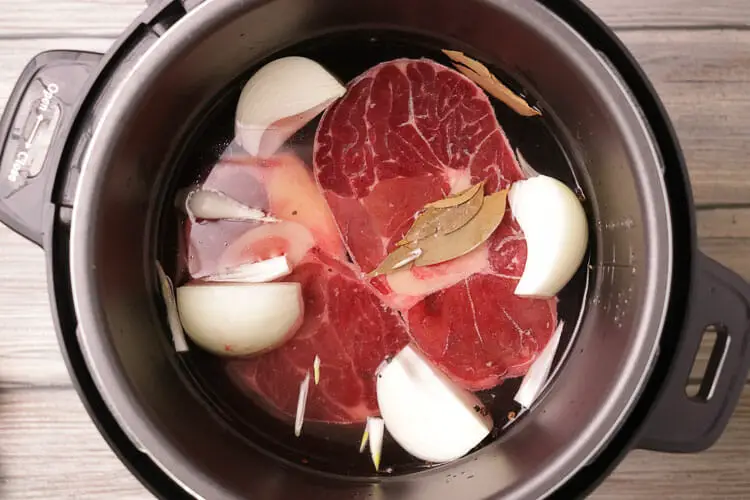
While the meat is cooking, you can start to prepare the pasta. Mound the flour on a work surface and make a well in the center. Add in beaten eggs, olive oil, and salt.

Mix with your fingers until the dough comes together into a ball, sprinkling water to moisten the dough as needed. Knead the dough for about 5 minutes or until smooth and elastic. Wrap with cling film and leave to rest for an hour.
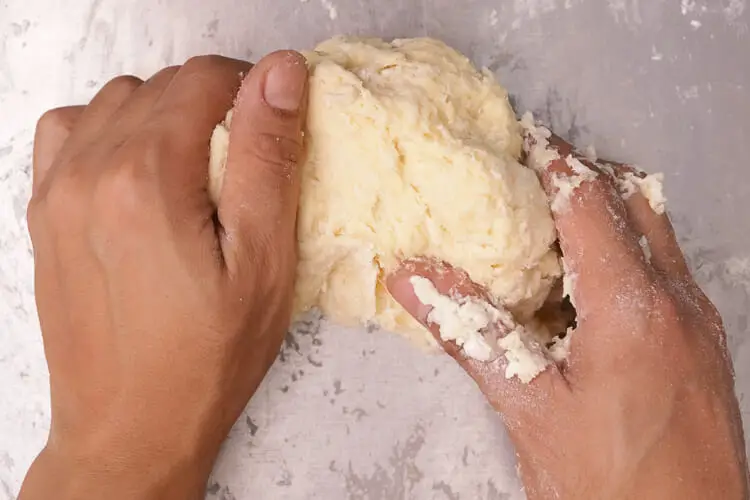
Cut the dough into workable portions, whether in half or into quarters.

Roll the dough out to a thickness of about 2mm, or as thin as you can get it. Use plenty of extra flour to stop the dough from sticking to the surface or the rolling pin.

Cut into two-inch squares using a knife or a rolling pizza slicer.
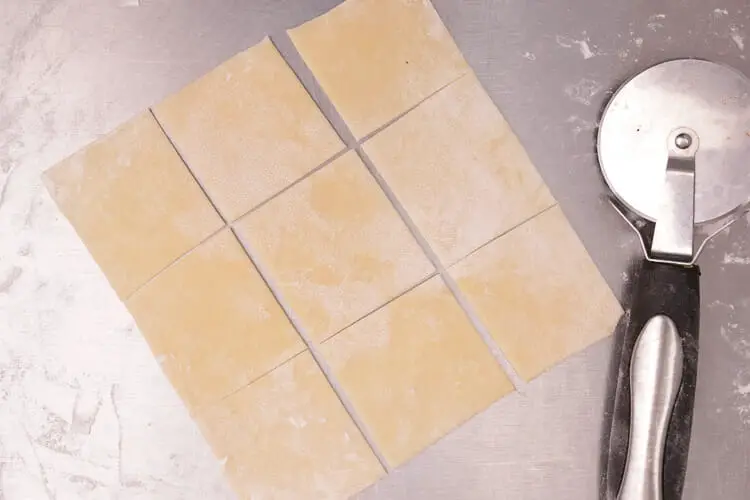
Once the beef is cooked and tender, take it out of the pot and set it on a colander to dry out any excess moisture. Keep the water the beef boiled in. Then take a knife and carve the meat into thin slices.

Bring the beef broth back to a boil and gently place the pasta squares into the water. Cook for 10-12 minutes.
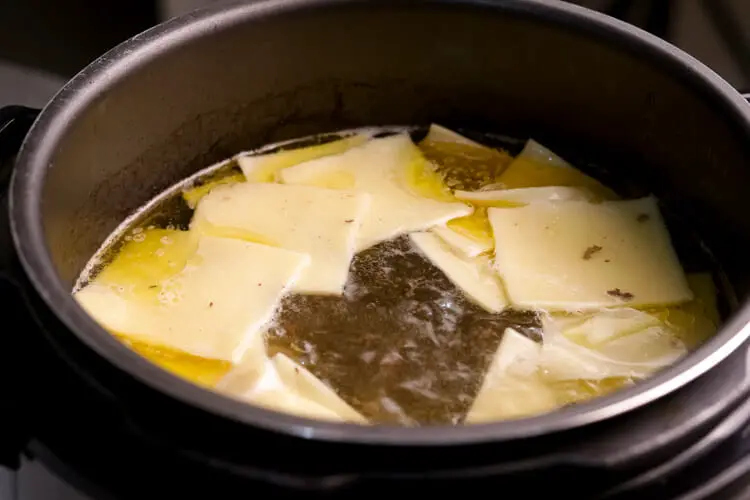
Next, heat about two tablespoons of olive oil in a pan. Add garlic and sauté until aromatic, but don’t let the garlic brown. Add the beef slices and stir, then season with salt and pepper to taste. Set aside.

In the same pan, toss the cooked pasta for a couple of minutes, just to gather up the flavors of the meat and garlic.

To serve, arrange the pasta on a large plate (if you’re planning on eating Kazakh style and having everyone take from the same dish) and pile the beef on top. Garnish with chopped parsley and chives.
Ас дәмді болсын!

OUR TAKE ON THE RECIPE
This besbarmak is a very straightforward dish that really showcases the robust flavor of good meat, beef in this case. Here at AA, we’re not always fans of recipes that are too fancy, so this besbarmak really hit the sweet spot for us in more ways than one. One of the main reasons we loved this dish was because it allowed the natural flavor of the beef be the star, and nothing else.
It’s also very easy to prepare – a one-pot meal that can be done on the stove, pressure cooker, or slow cooker (on Amazon). If we were to make it again, we might eschew the work of making our own pasta and include some dried fettuccine instead, which, in our opinion, would taste just as good. We might also add some chili flakes to the beef when sautéing it in a pan at the end, in an attempt to curtail a little of the richness of the beef.
Besbarmak is definitely a comforting meal too, and one that can be whipped up quite easily if you’re prepared to forego the homemade pasta.
Print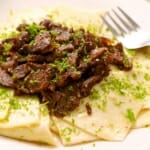
Kazakh Besbarmak
- Total Time: 3 hours 15 minutes
Ingredients
For the Meat Stock
- 2.5 lbs fatty lamb or beef on the bone, like beef or lamb shank, or a leg of lamb
- 1–2 large onions, cut into big chunks
- 2 bay leaves
- 1 tbsp of black peppercorns
- Pinch of salt
- 5 cloves of garlic, bashed
- 2 tbsp olive oil
For the Pasta
- 2 cups flour
- 2 eggs, beaten
- ¼ cup water
- ¼ tsp. salt
- 2 tsp. olive oil
For the Beef Saute
- 2–3 cloves of garlic, minced
- 2 tbsp. olive oil
Garnish
- Handful of chopped parsley
- Handful of chopped chives
Instructions
Step 1: Prepare the Meat
- Place the meat pieces in a pan and cover well with water.
- Add the onions, bay leaves, black peppercorns, bashed garlic cloves and salt.
- Cook until the meat is tender enough to fall off the bone. This should take 2-3 hours on the stovetop, 40 minutes in a pressure cooker, or about 8 hours in a slow cooker (on Amazon).
Step 2: Prepare the Pasta Dough
- Mound the flour onto a work surface and make a well in the center.
- Add in the beaten eggs, olive oil, water and salt.
- Mix with your fingers until the dough comes together into a ball, sprinkling water to moisten the dough as needed.
- Knead the dough for about 5 minutes or until smooth and elastic.
- Wrap with cling film and leave to rest for an hour.
- Cut the dough into workable portions and roll into 2mm thickness.
- Cut into 2-inch squares.
Step 3: Remove and Carve Beef; Cook the Pasta Squares
- Once tender, take the beef out of the pot and set on a colander to dry out any excess moisture.
- Carve into thin slices.
- Boil prepared pasta squares in the beef stock for 10-12 minutes. Drain.
Step 4: Sauté the Beef
- Heat about 2 tablespoons of olive oil in a pan over medium heat.
- Add garlic and sauté until aromatic. Do not brown.
- Add beef slices and stir. Season with salt and pepper to taste. Set aside.
Step 5: Serve up the besbarmak
- In the same pan, toss in cooked pasta.
- Arrange pasta on a serving plate and top with beef.
- Garnish with chopped chives or parsley.
- Prep Time: 15 min
- Cook Time: 3 hours
